This species has been observed on Reunion, Mauritius, Rodrigues, Mayotte and Madagascar Islands
The colour pattern ranges from very "dark form" to "plain yellow-brown form" with dark brown rings One consistent element of the colouration is a serie of narrow, opaque white semicircles that outline clusters of pustules Posteriorly, when it is crawling actively, the mantle was raised and folded to forme a very large and almost complete tubular siphon on the midline |

|
|
| Showing species characteristics... | Photo David Caron |
|
See more about : Pleurobranchus forskalii variability in Southwest Indian ocean
See more about : Sightening and mating periods
Remarks :
Identification confirmed by Nathalie Yonow
The plain yellow-brown form seems to be more frequent...
Synonymous : (according Worms)
- Oscanius semperi Vayssières, 1896 - Susania ceylonica White, 1948
- Pleurobranchus perrieri Vayssières, 1896 - Susania karachiensis White, 1946
Bibliographic data :
Adults are most often dark plum red, by they can vary from peach, through orange to dark purple . One consistent element of the colouration is a serie of narrow, opaque white semicircles that outline clusters of pustules. These semicircles are sometimes joined to form a reticulum and this is especially obvious in juveniles.
A triangular pale area present on the undersurface (pedal or metapodial gland) of the tail in sexually mature specimens
Juvenile has purple spots like P. grandis and P. peroni but P. forskali hasn't a ring of small tubercles around each of the large ones like P. grandis and has a white reticulate which absent from P. peroni
When it is crawling actively , the posterior end of the mantle is raised into a temporary spout that channels water and faeces rearwards. P. grandis is the only other species whose mantle form an exhalent spout when it is alive.
It lays a white spirally-arranged egg mass with one edge atached to the substrate and the other very wavy
It feeds on compound ascidian
P. forskalii is similar to P. albiguttatus, P. grandis, P. mamillatus and P. peroni but it is distinguished by the white semicircles on the mantle.
References :
Bill Rudman Seaslug site : Sea Slug Forum : Pleurobranchus forskalii
Publications :
Rüppell E. & Leuckart F.S. (1828-1830). Mollusca [in] Atlas zu des Reise im Nordlichen Afrika von Eduard Rüppell. 1. Abth. Zoologie. 5. Neue wirbellose Thiere des Rothen Meers. Frankfurt, H.L. Brönner pp. 1-22, pl. 1-12 [1828], pp. 23-47 [probably 1830
Other photos of Pleurobranchus forskalii :
Philippe Bourjon Reunion, 25 February 2017 Identification confirmed by A. Valdés
|
 |
 |
Philibert Bidgrain Mayotte, Mtsanga M'Titi Sada, less 1 m, 20 July 2010, size : 70 mm Adults are most often dark plum red. One consistent element of the colouration is a serie of narrow, opaque white semicircles that outline clusters of pustules.
|
 |
They have two well developed cylindrical rhinophores (a) on the head |
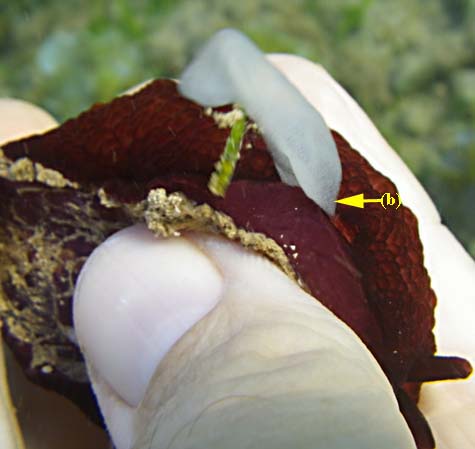 |
|
The spawn (b) : a white ribbon... |
Maurice jay Reunion, Juvenile has purple spots and a white reticulate pattern but hasn't a ring of small tubercles around each of the large ones like P. grandis. See sp N 68 in "Nudibranchs of Heron Island" R. C. Willan for comparaison
|
 |
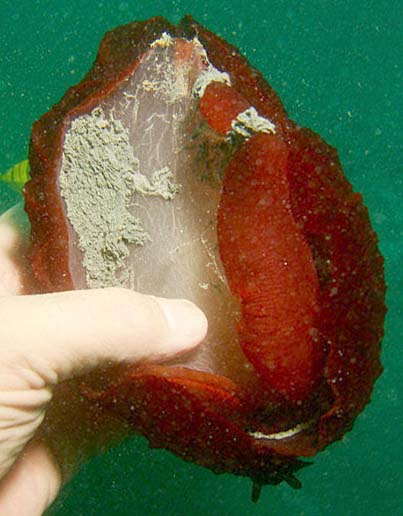 |
Yann von Arnim "Ferme marine" Mahebourg, Mauritius, January 2009, size : 120-150 mm Adults are most often dark plum red. One consistent element of the colouration is a serie of narrow, opaque white semicircles that outline clusters of pustules.
|
Philibert Bidgrain Reunion, Etang salé on the rocky coast, less 1 m, 7 November 2006, size : 12-15 mm Crawling during the day on the substrate This specimen looks like plain yellow-brown form of P. forskalii but this small specimen hasn't yet the serie of narrow, opaque white semicircles that outline clusters of pustules. So it could be a small specimen of P. forskalii "plain yellow-brown form" This specimen is very similar to Koretz's specimen in Opisthobranchs of Eilat
|
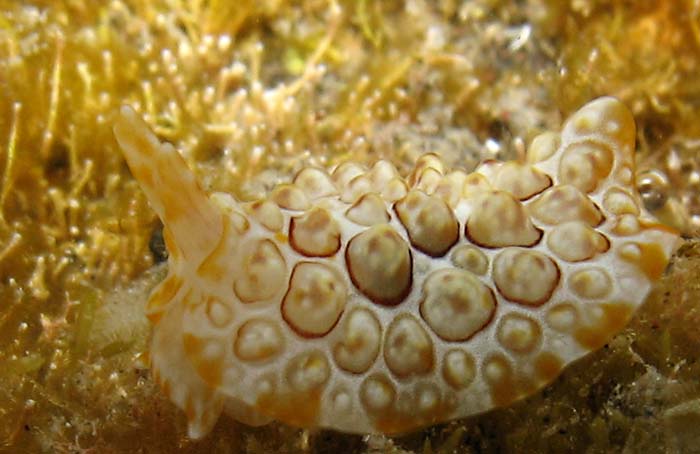 |
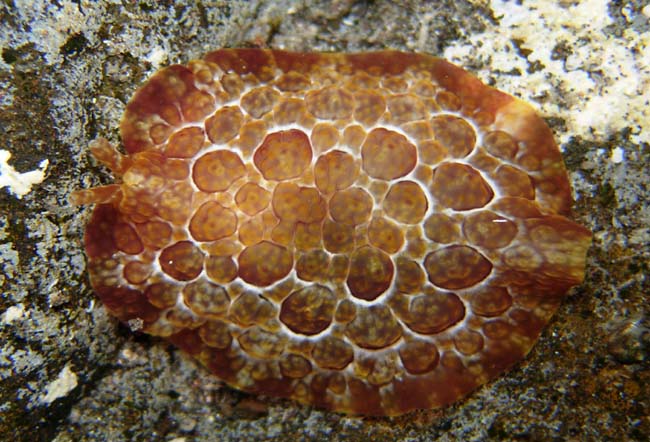 |
Christophe Cadet Réunion, Etang salé on the rocky coast, less 1 m, 14 December 2011, size : 25-30 mm
A specimen of the "plain yellow-brown form" with dark brown rings and the caracteristic serie of narrow, opaque white semicircles that outline clusters of pustules |
Christophe Cadet Réunion, Etang salé on the rocky coast, less 1 m, 2 January 2012, size : 40 and 50 mm
Two specimens of the "plain yellow-brown form", one yellow-brown and the second darker... The darker specimen looks like the "dark form"
|
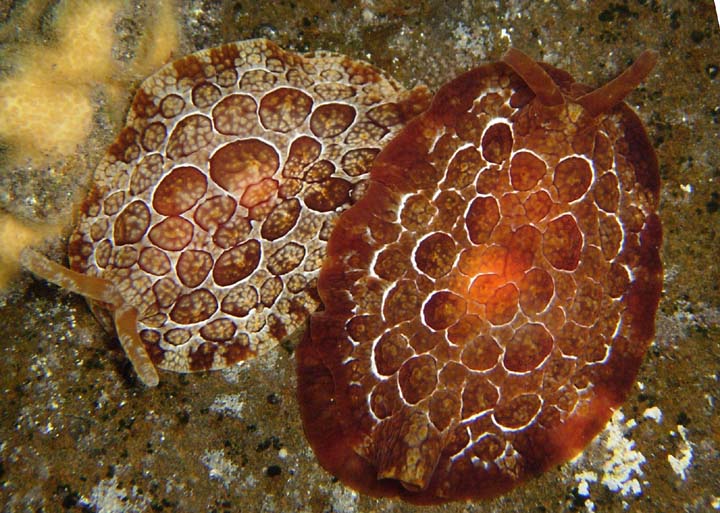 |
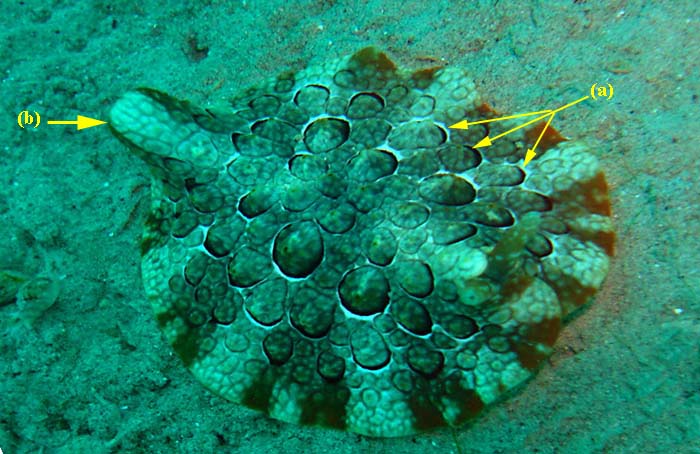 |
Yann von Arnim "ferme marine" Mahebourg, Bambou dive site, Mauritius, 5 October 2010, size : 60 mm A specimen of the plain yellow-brown form with dark brown rings and the caracteristic serie of narrow, opaque white semicircles (a) that outline clusters of pustules When it is crawling actively , the posterior end of the mantle is raised into a temporary spout (b), characteristic of this species |
More photos from Indian Ocean
See more about : Pleurobranchus forskalii variability in Southwest Indian ocean
Mauritius, brown form of Pleurobranchus forskalii, at Mahebourg, by Yann von Arnim
Reunion, juvenile form of Pleurobranchus forskalii, at Etang salé, by Christophe Cadet
Reunion, clear plum red form of Pleurobranchus forskalii, at Etang salé, by Christophe Cadet
Madagascar, Pleurobranchus forskalii, at Nosy Bé, by Alain-Benoît Rassat

